Science
Earthquake risks and rising costs: The price of operating California's last nuclear plant
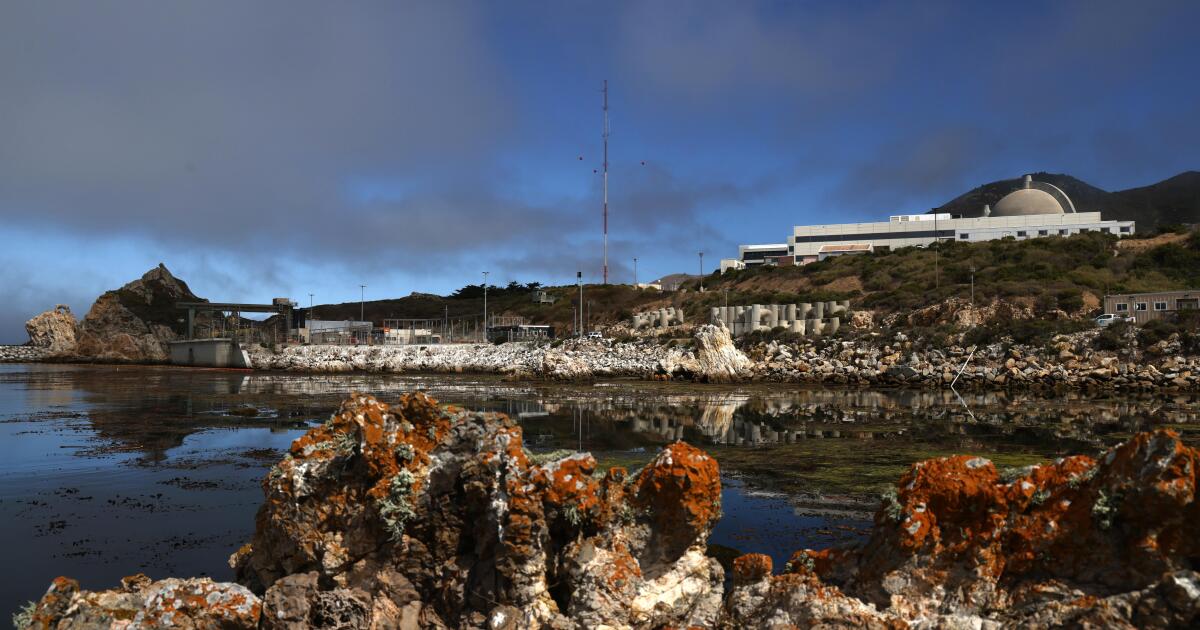
Under two gargantuan domes of thick concrete and steel that rise along California’s rugged Central Coast, subatomic particles slam into uranium, triggering one of the most energetic reactions on Earth.
Amid coastal bluffs speckled with brush and buckwheat, Diablo Canyon Nuclear Power Plant uses this energy to spin two massive copper coils at a blistering 30 revolutions per second. In 2022, these generators — about the size of school buses — produced 6% of Californians’ power and 11% of their non-fossil energy.
Yet it comes at almost double the cost of other low-carbon energy sources and, according to the federal agency that oversees the plant, carries a roughly 1 in 25,000 chance of suffering a Chernobyl-style nuclear meltdown before its scheduled decommissioning in just five years — due primarily to nearby fault lines.
Aggressive and impactful reporting on climate change, the environment, health and science.
As Gov. Gavin Newsom’s administration looks to the aging reactor to help ease the state’s transition to renewable energy, Diablo Canyon is drawing renewed criticism from those who say the facility is too expensive and too dangerous to continue operating.
Diablo is just the latest in a series of plants built in the atomic frenzy of the 1970s and ’80s seeking an operating license renewal from the federal Nuclear Regulatory Commission as the clock on their initial 40-year run ticks down. As the price of wind and solar continues to drop, the criticisms against Diablo reflect a nationwide debate.
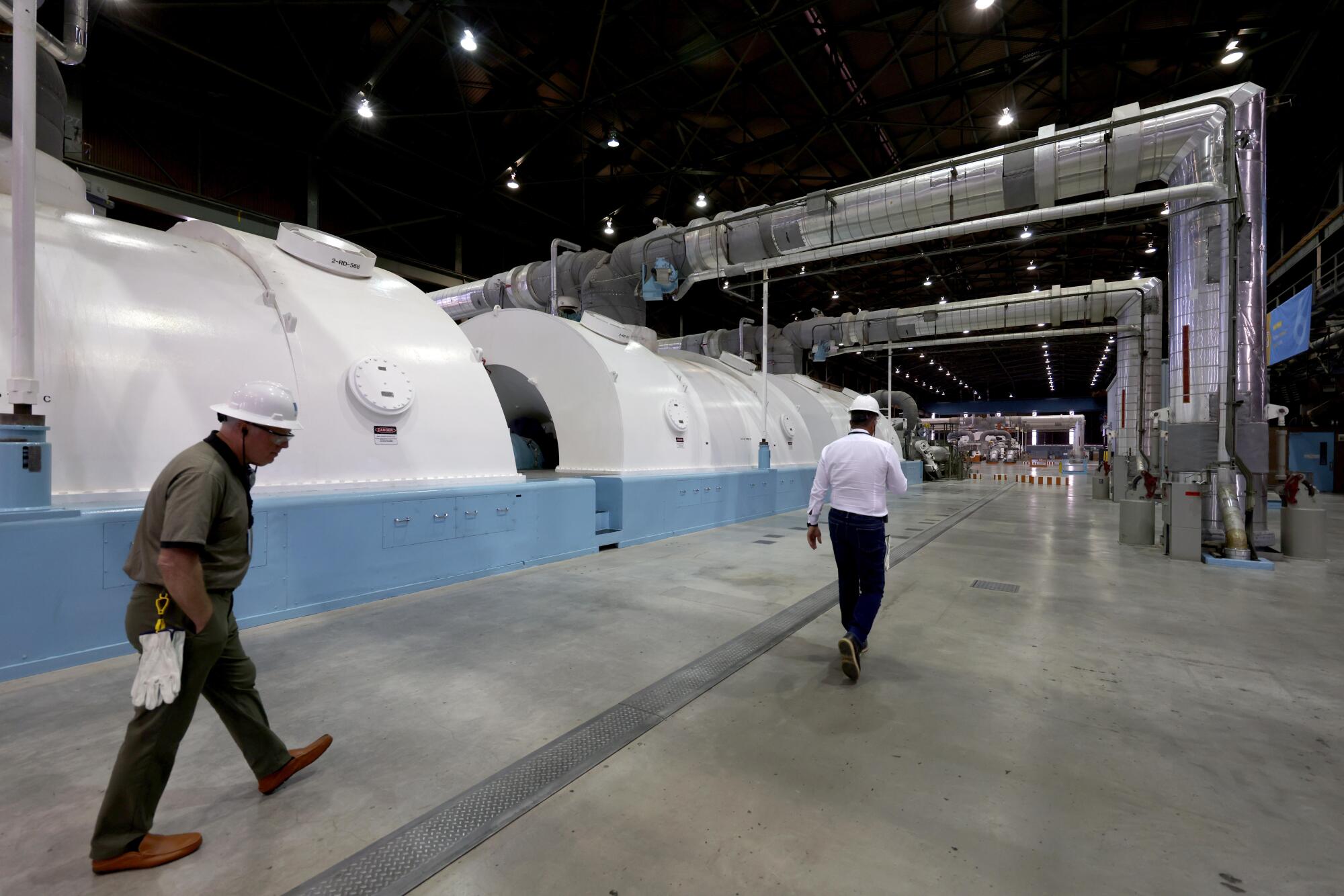
Tom Jones, right, a regulatory and environmental senior director at PG&E, and Jerel Strickland, a senior licensing and spent nuclear storage consultant, walk past one of two massive turbine-generator units inside the turbine building at Diablo Canyon Nuclear Power Plant recently.
(Genaro Molina/Los Angeles Times)
The core of the debate lives in the quaint coastal town of San Luis Obispo, just 12 miles inland from the concrete domes, where residents expected Diablo Canyon to shut down over the next year after its license expired.
Instead, Newsom struck a deal on the last possible day of the state’s 2021-22 legislative session to keep the plant running until 2030, citing worries over summer blackouts as the state transitions to clean energy. The activists who had negotiated the shutdown with PG&E and the state six years prior were left stunned.
Today, the plant is still buzzing with life: Nuclear fission, in the deep heart of the plant, continues to superheat water to 600 degrees at 150 times atmospheric pressure. Generators continue to whir with a haunting and deafening hum that reverberates throughout the massive turbine deck.
Left untouched, nuclear fission erupts into a runaway chain reaction that can heat the core of a nuclear plant to thousands of degrees, liquifying the metal around it into radioactive lava.
So, operators have to constantly stifle the reaction to keep it under control.
In the event of an earthquake, they need to stop the reaction as quickly as possible. But if the shaking is so rapid and intense that the plant is critically damaged before it can shut down, operators could become helpless in preventing a meltdown.
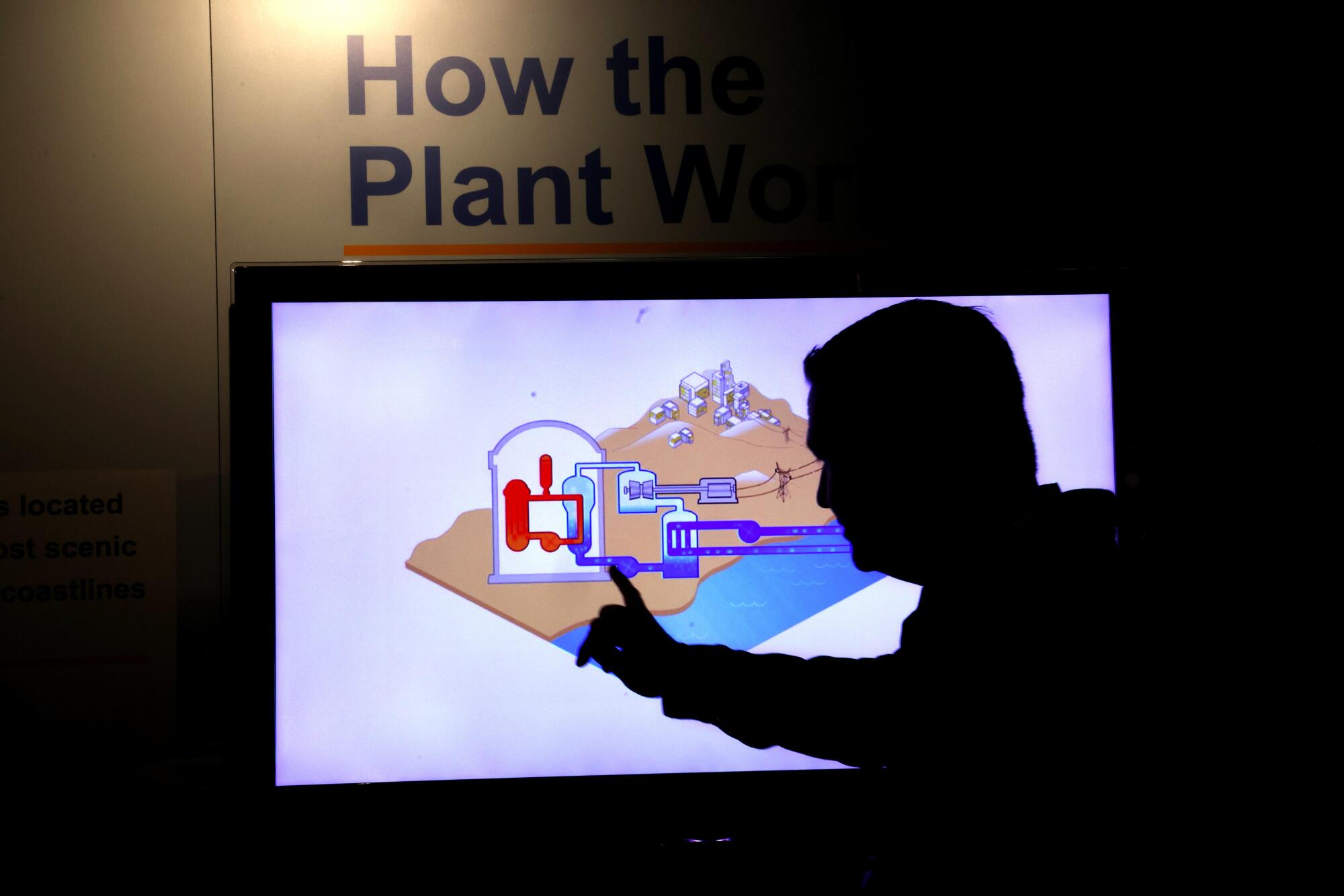
Tom Jones, senior director of Regulatory Environmental and Repurposing at PG&E, talks about how the Diablo Canyon Nuclear Power Plant operates.
(Genaro Molina/Los Angeles Times)
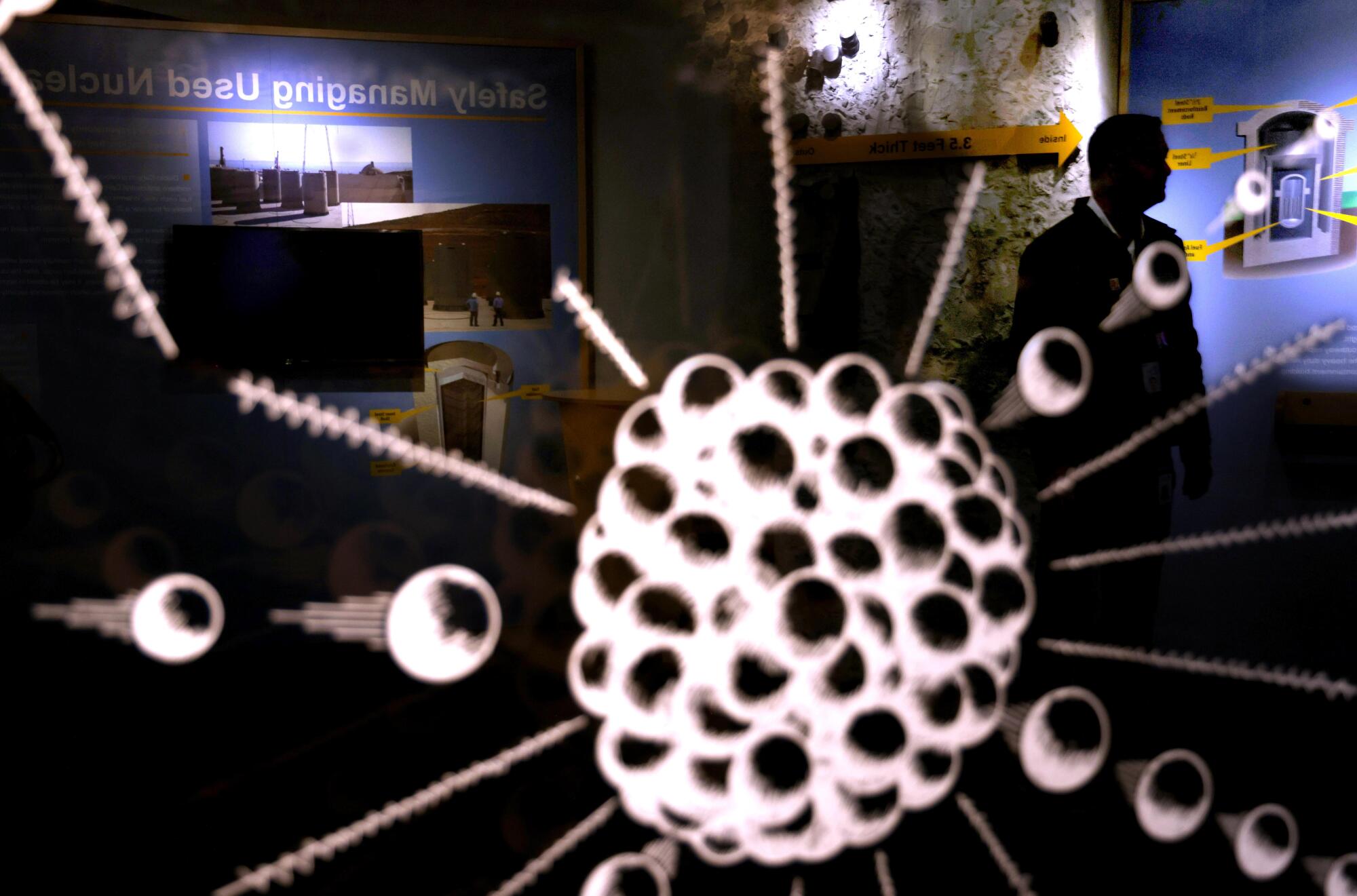
Tom Jones, senior director of Regulatory Environmental and Repurposing at PG&E, is reflected in a display that explains the fission process at Diablo Canyon Nuclear Power Plant recently.
(Genaro Molina/Los Angeles Times)
Diablo Canyon is built to endure specific intensities and speeds of shaking — but predicting how likely an earthquake is to exceed those specifications is no easy task. Earthquakes are the result of deeply complex underground motion and forces, and they’re notoriously chaotic.
In order to start estimating the seismic safety of the plant, geophysicists have to understand: first, where the faults are; second, how much they’re slipping to trigger earthquakes; and finally, when those quakes hit, how much shaking they cause.
Earthquakes account for about 65% of the risk for a worst-case scenario meltdown. Potential internal fires at the plant make up another 18%. The last 17% is made up of everything from aircraft impacts and meteorites to sink holes and snow.
In assessing the likelihood of all these threats, the Nuclear Regulatory Commission estimates that in any given year, each of Diablo Canyon’s two reactor units has a roughly 1 in 12,000 chance of experiencing a nuclear meltdown similar to Japan’s Fukushima disaster.
Likewise, there’s about a 1 in 127,000 chance a failure will cause the plant to release exorbitant amounts radioactive material into the atmosphere before residents could evacuate, creating a Chernobyl-style disaster.
This means that, every year, nearby residents have roughly the same chance of seeing a nuclear meltdown as dying in a car crash. Also, in any given year, they’re about 50 times more likely to face a mass-casualty radioactive catastrophe than get struck by lightning.
Diablo Canyon employees work around the clock to ensure the risk is as small as possible. “Our safety culture, it’s always on the top of my mind,” said Maureen Zawalick, the vice president of business and technical services at Diablo. “It’s in my DNA.”
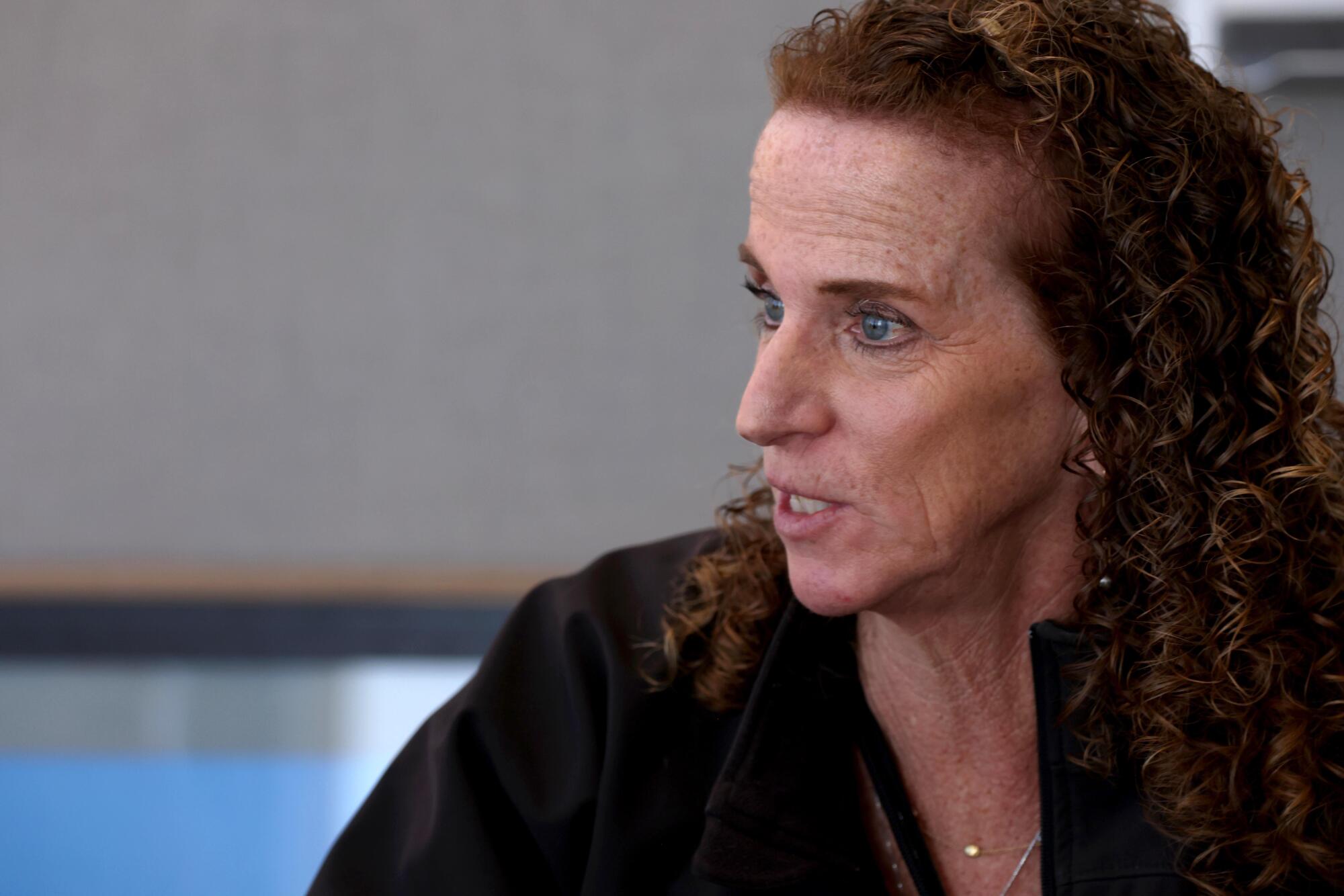
Maureen Zawalick, PG&E Business and Technical Services vice president, in her office at the Diablo Canyon Power Plant.
(Genaro Molina/Los Angeles Times)
The plant is the only one in the U.S. with a dedicated geoscience team that studies the region’s seismic landscape. And like other nuclear facilities, Diablo has done countless tests on its equipment, hosted walkthroughs with regulators to identify possible points of failure and generated thousands of pages of analysis on the facility’s ability to withstand the largest earthquake possible at the site.
Earthquake precautions include massive metal dampers that are fixed to essential infrastructure, such as the duct carrying the control rooms’ air supply. In the event of a tremor, monstrous concrete pillars penetrate deep into the bedrock to keep the building and essential infrastructure grounded. The hefty concrete walls reinforced with steel rebar as thick as a human arm safely distribute the forces throughout the structure to prevent critical cracks or collapses.
If the plant loses power, there are backup generators for the backup generators.

A worker pushes a utility cart past a billboard that lists employee goals at Diablo Canyon Nuclear Power Plant recently.
(Genaro Molina/Los Angeles Times)
Operators spend a fifth of their time on the job training for every possible nightmare. Diablo has a simulator on site that’s an exact replica of the Unit One control room. It’s capable of putting operators through the worst conditions imaginable. It shakes with the vigor of a real earthquake. The lights flicker and the analog dials spin back up as emergency power comes online.
For everyone working on site — including the senior leadership team — safety is personal. Should something go wrong, their lives are on the line.
“With any source of energy, there is risk,” said Zawalick. “All the independent assessments, all the audits, all the third party reviews, all of that …. is what gives me the confidence and the security and the safety of why I’ve been out here almost 30 years.” Her office is no more than 500 feet from the reactors.
“If there ever was an earthquake of any magnitude in this community,” she said, “I would grab my two daughters and we’d come here.”

Maureen Zawalick, PG&E Business and Technical Services vice president, looks out her office window at Diablo Canyon Nuclear Power Plant recently.
(Genaro Molina/Los Angeles Times)
Many critics charge that the risks are understated — due in part to a cozy relationship between industry and regulators. (Some scientists involved with one of Diablo Canyon’s two independent review organizations have collaborated on scientific papers with PG&E staff and funding.)
The Nuclear Regulatory Commission also oversees the plant and conducts its own investigations. In July, the government agency dismissed all three formal criticisms against Diablo’s seismic safety in the plant’s license renewal process.
Sam Blakeslee, a San Luis Opispo geophysicist and former state senator and Assembly member, has a list of technical concerns — primarily the lack of shaking data close to fault lines, which are used to inform the models that predict earthquake motion at the plant — but he likens the core of his concern to the NASA Challenger disaster.
NASA publicly touted a strong safety culture and low chances of things going wrong. Yet, the investigation found political and public pressures had corrupted the safety from the top down.
He argues this is a possibility for any large organization dealing with complex and potentially dangerous systems. Therefore, people need to constantly hold the plant accountable.
“That’s why I tend to try to make sure that the community voice is present,” he said, “ because we are the ones that will pay the price.”
In 2022, Newsom introduced a proposal to keep Diablo Canyon open past its two reactors’ 2024 and 2025 shutdown dates. His proposal, distributed to lawmakers just three weeks before the end of the legislative session, set off a flurry of negotiations among PG&E, the governor and the Legislature.
After discussion drew on past midnight, the Legislature passed the bill.
But it comes at a cost.
While the average price of solar and wind have dropped dramatically over the past 15 years, nuclear’s has been steadily rising. In 2009, solar cost three times what nuclear did, and wind was about even with it. Now, nuclear is over two times the cost of both renewables.
Technical advancements have slashed the price of renewable energy, but nuclear power has faced more outages, equipment replacements and increasingly stringent and expensive safety requirements in the wake of the Fukushima disaster.
One study from MIT researchers found that about a third of the increasing cost could be attributed to safety requirements from the Nuclear Regulatory Commission. They attribute another third to research and development projects for efficiency, reliability and safety improvements, and they assign the final third to a decrease in worker productivity — perhaps in part due to lower morale.

Twin containment domes rise above the facility as seen through a windshield on the drive to the Diablo Canyon Nuclear Power Plant.
(Genaro Molina/Los Angeles Times)
PG&E is estimating that Diablo Canyon will produce energy at $91 per megawatt-hour during its extension. (The average U.S. household buys about 10 megawatt-hours every year.)
However, the Alliance for Nuclear Responsibility argues the plant’s cost is even higher. David Weisman, the legislative director at the alliance, said PG&E is using optimistic predictions of its energy output for the extended period — 5% higher than previous years.
On top of that, the state gave PG&E a $1.4-billion loan to alleviate the initial costs of extended operations. But Wiesman said the funds don’t necessarily need to go toward offsetting the cost of running Diablo. The federal government agreed to reimburse the state up to $1.1 billion — depending on whether the plant meets specific operating criteria — and PG&E is expected to pay off the rest of the loan with profits.
While the loan isn’t a cost that consumers would see on their energy bills, taxpayers across the country could foot the bill. Weisman argued that it brings Diablo’s cost to a maximum of $115 per megawatt-hour — roughly double the cost of solar.
Yet Newsom argues that if California is to meet its goals of 60% renewable energy by 2030, Diablo needs to stay online in the meantime to ensure the state has reliable power amid heatwaves and wildfires.
Diablo Canyon essentially runs 24/7, providing constant power to the state (assuming it doesn’t have any issues, which it sometimes does). For solar to provide similarly constant power, the electric grid will require a massive expansion of its battery infrastructure to store the energy between the midday peak of energy production and the evening peak of energy use.
However, new studies are finding that energy storage is a feasible approach to grid reliability — and that even when adding the price of that infrastructure, solar still costs less than nuclear.

Tom Jones, a regulatory and environmental senior director at PG&E, talks about the number of days that Turbine Unit One has operated to bring power to California while inside the turbine building at Diablo Canyon Power Plant recently.
(Genaro Molina/Los Angeles Times)
Since Diablo’s extension was signed into law, California has almost doubled its battery storage. The state now has enough to supplement about a quarter of the state’s power needs for about half an hour during peak energy usage (although, in practice, it would likely supplement much less for much longer).
“That’s four or five Diablo Canyons,” said Weisman. Newsom should “save the people of California [billions of dollars] thrown down PG&E’s rat hole, declare triumphant victory in the renewable race and accept the laurels.”
Instead, at a recent press event announcing California had reached a fifth of its storage capacity goal, Newsom laughed off the idea that Californians will no longer have to worry about blackouts.
“We have a lot of work to do still in moving this transition, with the kind of stability that’s required,” he said. “So no, this is not today announcing that blackouts are part of our past.”
Diablo Canyon’s leaders and advocates view the plant as supporting California through this challenging transition period: It’s not perfect, but it provides the state with much-needed reliable, clean power, they say.
In a conference call shortly after Diablo’s initial 2024 shutdown date was negotiated, then-chief executive of PG&E Tony Earley acknowledged the plant would eventually become too expensive to operate.
“As we make this transition, Diablo Canyon’s full output will no longer be required,” he said.
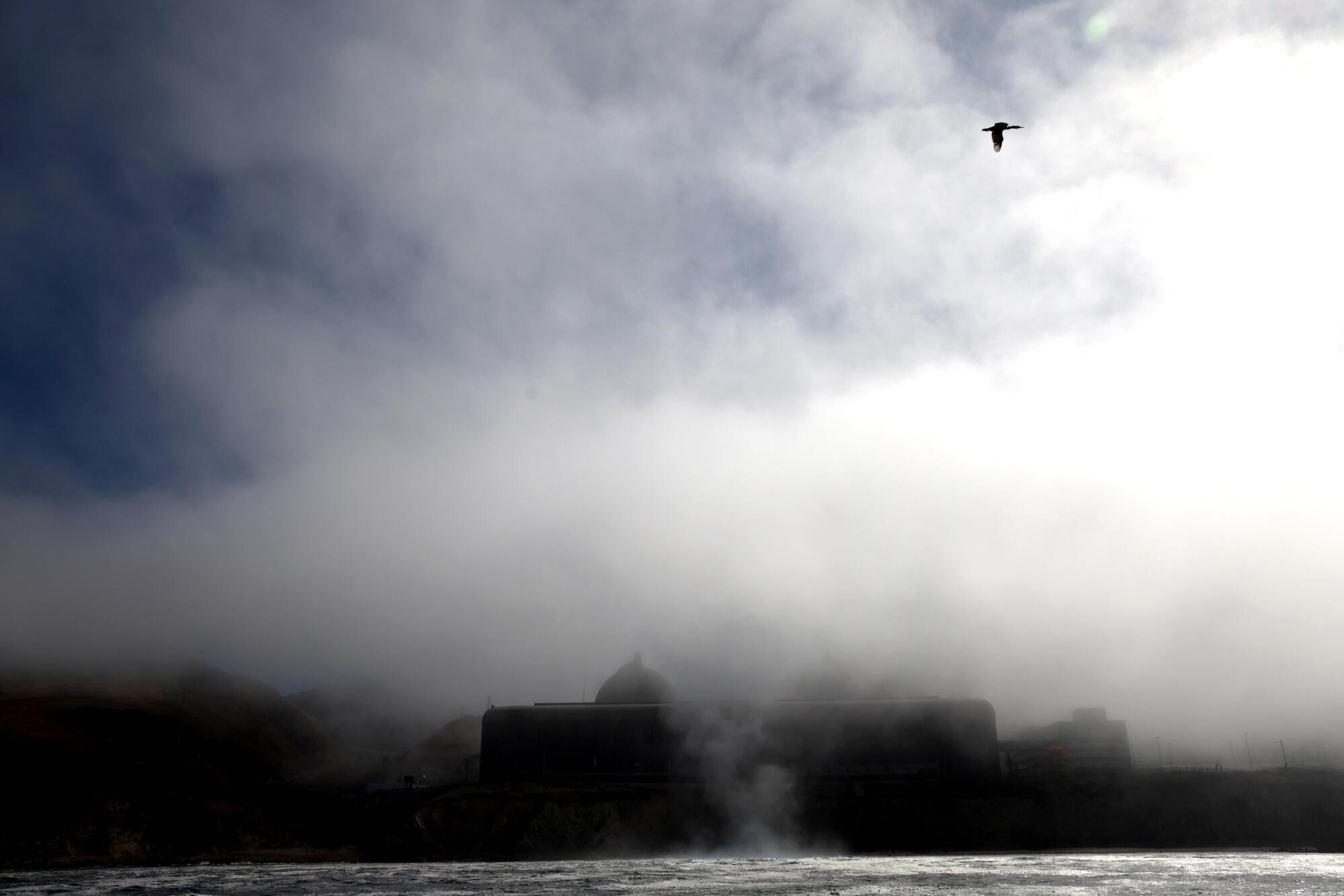
Steam rises from the Pacific Ocean where an outfall of heated water from the Diablo Canyon Nuclear Power Plant pours into coastal waters.
(Genaro Molina/Los Angeles Times)
Zawalick said the Diablo team is ready to continue operating as long as the state needs it to. “Thinking about electrification, [electric vehicle] demand, continued drought, the temperatures we’re seeing, wildfires … tariffs — I mean, the list goes on,” she said. “That’s making the equation a bit challenging to see exactly when Diablo will shut down versus how long Diablo will be needed by the state.”

Science
Video: Engineer Is First Paraplegic Person in Space

new video loaded: Engineer Is First Paraplegic Person in Space
transcript
transcript
Engineer Is First Paraplegic Person in Space
A paraplegic engineer from Germany became the first wheelchair user to rocket into space. The small craft that blasted her to the edge of space was operated by Jeff Bezos’ company Blue Origin.
-
Capsule touchdown. There’s CM 7 Sarah Knights and Jake Mills. They’re going to lift Michi down into the wheelchair, and she has completed her journey to space and back.

December 21, 2025
Science
This City’s Best Winter Show Is in Its Pitch-Dark Skies

The result is a starry sky visible even from the heart of the city. Flagstaff’s Buffalo Park, just a couple miles from downtown, measures about a 4 on the Bortle scale, which quantifies the level of light pollution. (The scale goes from 1, the darkest skies possible, to 9, similar to the light-polluted night sky of, say, New York City. To see the Milky Way, the sky must be below a 5.)
Science
Social media users in the Central Valley are freaking out about unusual fog, and what might be in it
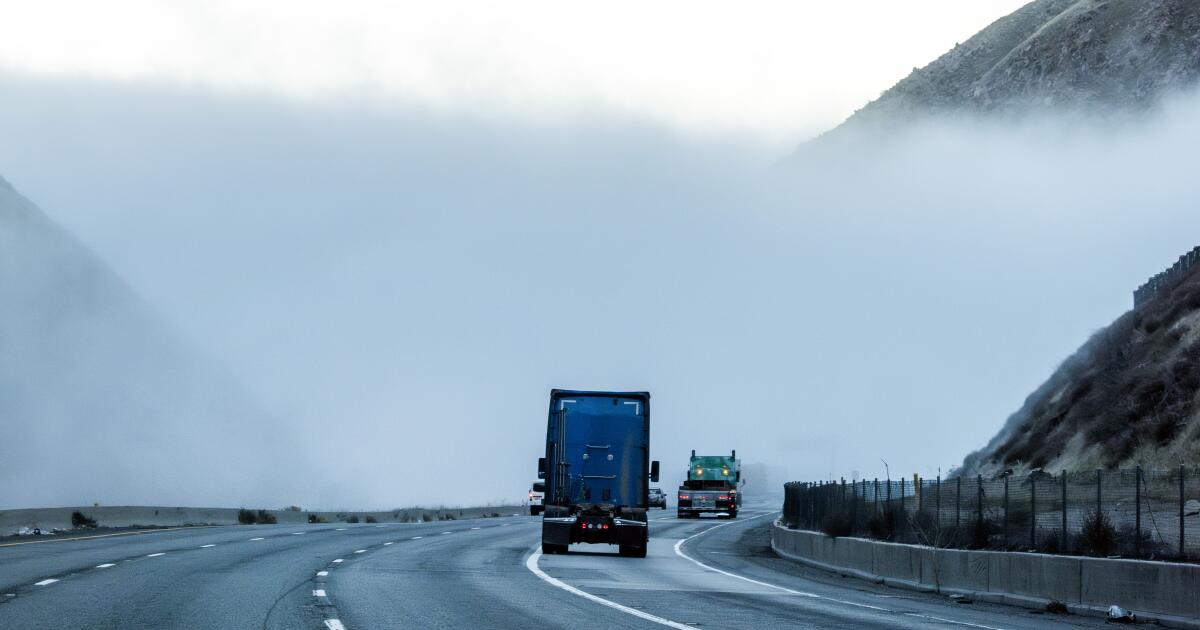
A 400-mile blanket of fog has socked in California’s Central Valley for weeks. Scientists and meteorologists say the conditions for such persistent cloud cover are ripe: an early wet season, cold temperatures and a stable, unmoving high pressure system.
But take a stroll through X, Instagram or TikTok, and you’ll see not everyone is so sanguine.
People are reporting that the fog has a strange consistency and that it’s nefariously littered with black and white particles that don’t seem normal. They’re calling it “mysterious” and underscoring the name “radiation” fog, which is the scientific descriptor for such natural fog events — not an indication that they carry radioactive material.
An X user with the handle Wall Street Apes posted a video of a man who said he is from Northern California drawing his finger along fog condensate on the grill of his truck. His finger comes up covered in white.
“What is this s— right here?” the man says as the camera zooms in on his finger. “There’s something in the fog that I can’t explain … Check y’all … y’all crazy … What’s going on? They got asbestos in there.”
Another user, @wesleybrennan87, posted a photo of two airplane contrails crisscrossing the sky through a break in the fog.
“For anyone following the dense Tule (Radiation) fog in the California Valley, it lifted for a moment today, just to see they’ve been pretty active over our heads …” the user posted.
Scientists confirm there is stuff in the fog. But what it is and where it comes from, they say, is disappointingly mundane.
The Central Valley is known to have some of the worst air pollution in the country.
And “fog is highly susceptible to pollutants,” said Peter Weiss-Penzias, a fog researcher at UC Santa Cruz.
Fog “droplets have a lot of surface area and are suspended in the air for quite a long time — days or weeks even — so during that time the water droplets can absorb a disproportionate quantity of gasses and particles, which are otherwise known as pollutants,” he said.
He said while he hasn’t done any analyses of the Central Valley fog during this latest event, it’s not hard to imagine what could be lurking in the droplets.
“It could be a whole alphabet soup of different things. With all the agriculture in this area, industry, automobiles, wood smoke, there’s a whole bunch” of contenders, Weiss-Penzias said.
Reports of the fog becoming a gelatinous goo when left to sit are also not entirely surprising, he said, considering all the airborne biological material — fungal spores, nutrients and algae — floating around that can also adhere to the Velcro-like drops of water.
He said the good news is that while the primary route of exposure for people of this material is inhalation, the fog droplets are relatively big. That means when they are breathed in, they won’t go too deep into the lungs — not like the particulate matter we inhale during sunny, dry days. That stuff can get way down into lung tissue.
The bigger concern is ingestion, as the fog covers plants or open water cisterns, he said.
So make sure you’re washing your vegetables, and anything you leave outside that you might nosh on later.
Dennis Baldocchi, a UC Berkeley fog researcher, agreed with Weiss-Penzias’ assessment, and said the storm system predicted to move in this weekend will likely push the fog out and free the valley of its chilly, dirty shawl.
But, if a high pressure system returns in the coming weeks, he wouldn’t be surprised to see the region encased in fog once again.
-

 Iowa7 days ago
Iowa7 days agoAddy Brown motivated to step up in Audi Crooks’ absence vs. UNI
-

 Iowa1 week ago
Iowa1 week agoHow much snow did Iowa get? See Iowa’s latest snowfall totals
-

 Maine5 days ago
Maine5 days agoElementary-aged student killed in school bus crash in southern Maine
-

 Maryland1 week ago
Maryland1 week agoFrigid temperatures to start the week in Maryland
-

 South Dakota1 week ago
South Dakota1 week agoNature: Snow in South Dakota
-

 New Mexico5 days ago
New Mexico5 days agoFamily clarifies why they believe missing New Mexico man is dead
-

 Detroit, MI6 days ago
Detroit, MI6 days ago‘Love being a pedo’: Metro Detroit doctor, attorney, therapist accused in web of child porn chats
-

 Education1 week ago
Education1 week agoOpinion | America’s Military Needs a Culture Shift
















